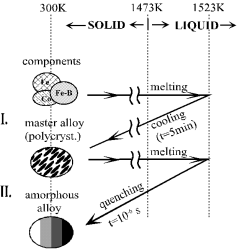Metallic glasses and related systems prepared by rapid quenching from the melt exhibit, unlike conventional polycrystalline matter, specific features related to local spatial (dis)ordering of atoms and to local chemical composition resulting from freezing of the melt structure and leading to the formation of complex metastable amorphous structure. These features lead to novel properties of metastable systems controlled by micro and nanostructure and yield high-performance materials with special nonconventional combinations of properties generally absenting in stable-state materials.
Physical procedure of preparation of metallic glasses by rapid quenching consists of two steps:
- melting of suitable components corresponding to the desired final chemical composition of the material, yielding homogeneous polycrystalline master alloy (in stable state)
- melting of master alloy and its rapid quenching to obtain amorphous structure (in metastable state)
By this procedure complex amorphous and nanocrystalline structure in form of thin ribbons is obtained.


Physical Research of Complex Disordered Structures is Focused on:
- amorphous, nanocrystalline and quasicrystalline systems
- thermodynamics of amorphous (metastable) state
- short-range ordering in rapidly quenched structures
- phase transitions, stability and rates of transformation
- structure and phase analysis
- computer simulation of atomic and electronic structure
- magnetic properties (magnetic anisotropy, mechanism of remagnetization, magnetisation, permeability, coercivity, magnetic aftereffects)
- mechanical and magnetoelastic properties, Curie temperature
- melt properties and solidification process
- atomic and electron transport (viscosity, electrical conductivity, Hall effect, giant magnetoresistance)
Methods of Research:
- electron microscopy (TEM, ED, HREM, SEM, EDX)
- X-ray spectroscopy
- positron annihilation lifetime methods
- thermoanalytical methods (DSC, DTA)
- high precision electrical resistivity
- magnetostriction
- dilatation
- microprocess modelling
- atomic and electronic structure simulation
- magnetic and magnetoelastic characterization
- densitometry
- chemical analysis (ICP)




